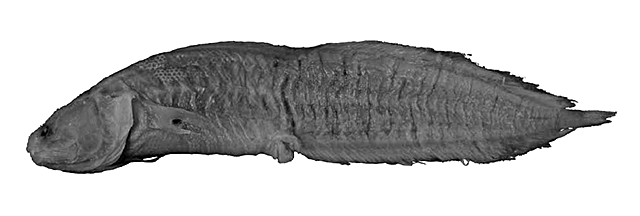| Dinematichthyidae (Viviparous brotula) |
| 5.4 cm SL (male/unsexed); 6 cm SL (female) |
|
reef-associated; marine; depth range 0 - 5 m |
| Western Pacific: Australia. |
|
Dorsal soft rays (total): 69-77; Anal soft rays: 52-61; Vertebrae: 42-45. This species is diagnosed by the following characters: D 69-77; A 52-61; D/A 23-26, V in D 1.9-2.1; vertebrae 12+30-33=42-45; multiple small cirri on occiput; a single (outer) pseudoclasper wing-shaped with 2 slender supporters, slightly bent, particularly the posterior one and are exactly of same length; 3-5 rows of scales on upper part of cheek, 2 rows on its lower part; otolith has a moderately pointed anterior tip and pronounced postdorsal angle, with undivided short sulcus, its centre anterior to centre of otolith, inclined with 5 to 10°, the otolith length to otolith height is 2.2, otolith length to sulcus length is 2.2-2.4 (Ref. 76869). |
| Some of the female specimens were observed to have 9-18 eggs in the body cavity, 2 females (of 44 mm SL) were opened and found to contain orange-coloured eggs, 1.4-1.7
mm in diameter; no reported specimens have embryos inside. This observation apparently indicate that this species is oviparous rather than viviparous, which is an assumed diagnostic character for all Bythitoidei. However, this first indication will need to be confirmed by in-life observation (Ref. 76869). |
|
Least Concern (LC); Date assessed: 16 August 2019 Ref. (130435)
|
|
|
Source and more info: www.fishbase.org. For personal, classroom, and other internal use only. Not for publication.

